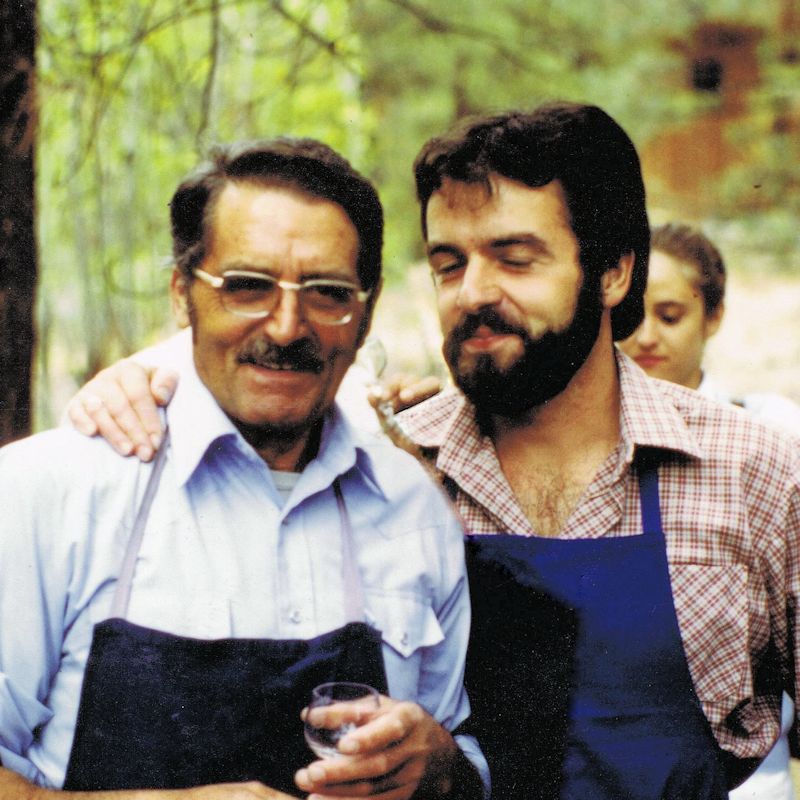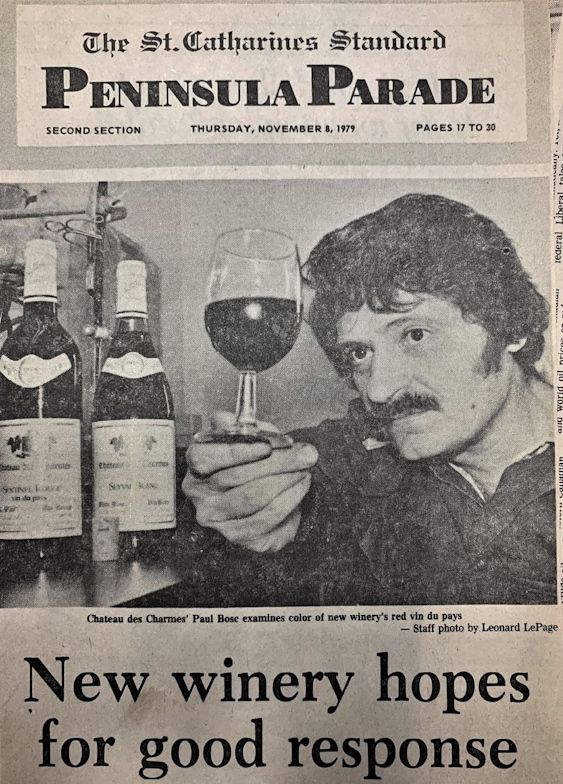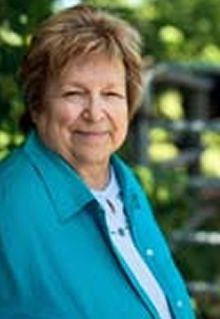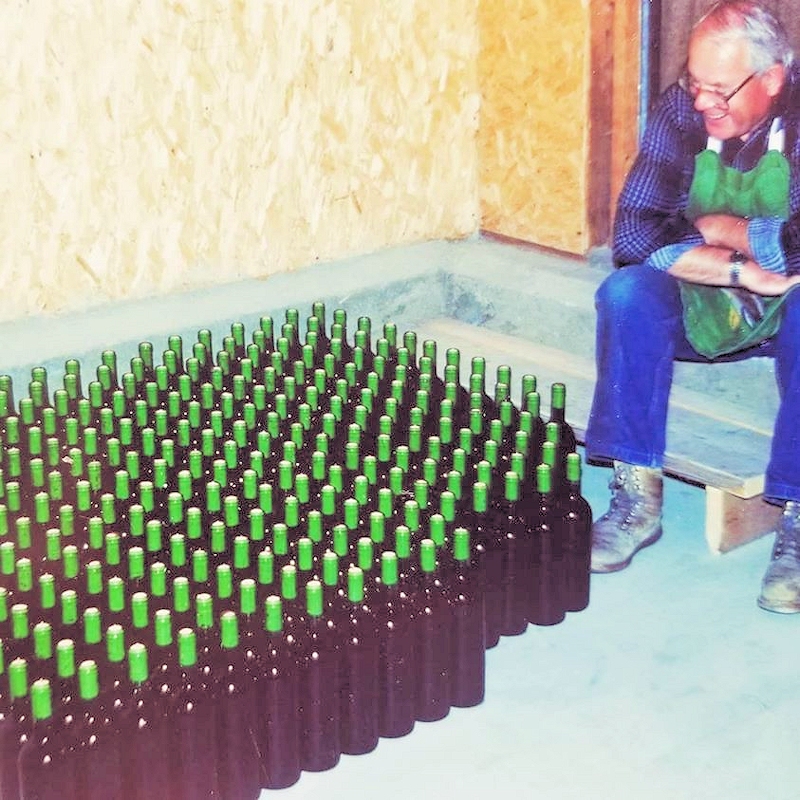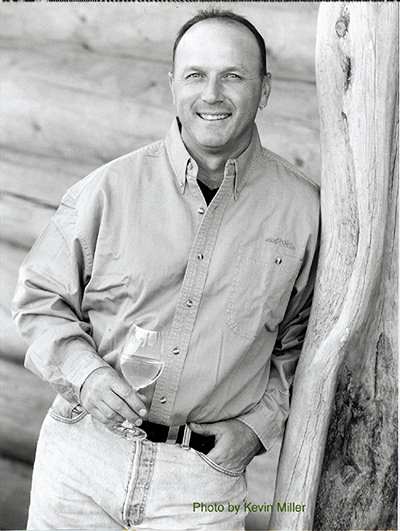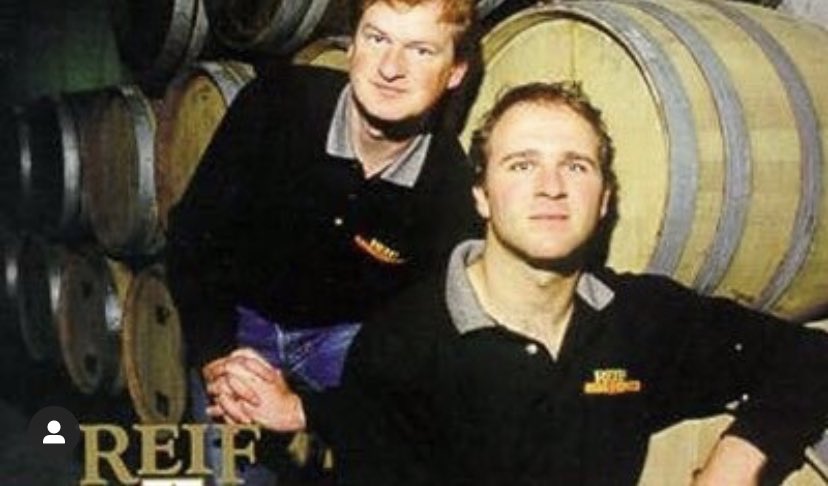Robert Bell's
Wines of Canada
Since 1992
The Names Behind Winemaking in Canada
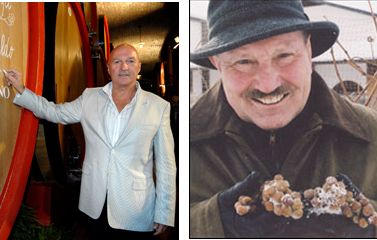
Donald Ziraldo and Karl Kaiser
Donald Ziraldo co-founder Inniskillin (1974) he sold the wines . Through his hard work Icewine became synonymous Canada . More on Donald Ziraldo
Karl Kaiser co-founder Inniskillin (1974) he made the wines. Donald Ziraldo refers to Karl as the mastermind behind the Renaissance in Icewine.
Karl Podamer was granted a manufacturer's license to make sparkling wine in 1973. Since his wine required two years in the bottle before it could be sold his retail license was granted 24 days after Karl Kasier and Donald Ziraldo's licence. His winery was called Montravin and Podamer Champagne Company which was sold to Magnotta Wines in 1993.
Walter Davidson, Raised on a Penticton-area farm, Davidson was pursuing a career as a teacher in Quesnel when his father-in-law, Evans Lougheed, convinced him in 1974 to buy a hundred-acre plus vineyard on a plateau overlooking Osoyoos. It had been developed by Lougheed with his brother Alan and with several founding shareholders of Casabello Wines to produce fruit for the winery; the shareholders now wanted to sell it. One quarter of the vineyard was planted to an admirable range of vinifera grapes, including pinot noir, merlot, carignan among the reds; and chenin blanc, chardonnay, grey riesling, sauvignon blanc, semillon and johannisberg riesling among the whites. Davidson added another ten acres of vinifera, leaving the remainder of the vineyard in hybrid varieties. This noble vinifera thrust ended abruptly late in October 1978 on a day when the temperature plunged abruptly from shirt-sleeves at lunch to freezing water lines in the early evening -- and stayed cold. Because the vines had not yet become dormant, almost all were frozen to the roots except for the semillon. This was a major financial blow to Davidson who had insurance only on the surviving hybrids, coverage then not being available for vinifera. Davidson prudently replanted with hybrids: foch, verdelet and seyval blanc. These comprised the bulk of the thirty-seven acres of grapes Davidson retained after the 1988 pullout when he removed about eighty acres of vines to plant exotic apple varieties. Subsequently, the verdelet and the seyval blanc also have been removed, victims to lagging winery demand. "I'd sooner grow apples," Davidson says, adding with a chuckle: "In this family, that's heresy."
Richard Cleave A British Columbian, vineyard manager who may have planted over a 1000 acreas of vines in the Okanagan. His career started in 1975 at Shannon Vineyards. . In 1991 he established his own vineyard on Black Sage Road (as the residents call 71st Street), planting fourteen acres of premium varieties and giving him the option of establishing a small winery. However, his first love is growing grapes, leaving others to make the wines. In 1993, when new owners acquired the land that once was Shannon and Pacific, Cleave, who had now formed a management and contract planting company with Osoyoos orchardist Robert Goltz, once again became manager of the adjoining vineyards, now called Black Sage, Sunset and Burrowing Owl.
Albert LeComte, LeComte was born in Prince Albert, Saskatchewan, into a family with no wine heritage (his father was an electronics technician in the air force). After a business career in automobile repair and electric sign manufacturing in Vancouver, LeComte moved to Oliver in 1975 to represent the sign business he and his brother, Maurice, operated. A home winemaker, he bought a vineyard near Okanagan Falls in 1983 and immediately began developing the LeComte Estate Winery, which received its license in 1986. A restless entrepreneur, LeComte had the winery for sale several times, perhaps because winemaking tasks conflicted with other interests that range from real estate development to fishing in Mexico. The winery was sold in 1995 to a group of investors headed by Harry McWatters and Robert Wareham.
Joe Ritlop founded St. Laszlo Vineyards Estate Winery in 1976 perhaps the first winery in the Similkameen Valley. It was a fruit and grape winery. He grew clinton, delaware and interlaken, along with the more contemporary varieties now common in the valley. Joe Ritlop was born in the former Yugoslavian town of St. Laszlo, and his wines have an Eastern European feeling
Dr Helmut Becker head of the German Geisenheim Institute. He traveled to the Okanagan and Ontario advising on which plants would be best suited to the region. In the Okanagan he supplied free of charge twenty-seven Vinifera Varieties for trial in 3 acre test plots running from 1977 to 1985. They included Pinot Blanc, Ehrenfelser, Müller-Thurgau and Riesling. These trials became known as the Becker Project . In Ontario he worked with Paul Bosc.
John Marynissen in 1976 began growing Merlot, Chardonnay, Riesling and Gamay. In 1978 he became the first Canadian to plant the Bordeaux Cabernet Sauvignon
John Paroschy a member of the T.J.Bright Company research team who in 1978 tested the use of Vidal for icewine. He later joined Chateau des Charmes
Dr. Joseph Pohorly was one of the first winery owners in Niagara. He founded Newark Winery in the Village of Virgil in 1979, one of the three original cottage wineries that opened in Niagara in the '70s and laid the foundation for the growth of the new Ontario wine industry. Joseph himself was no stranger to wines. Born in Vineland, Ontario, he began life as a farmer's son and learned how to grow grapes and other fruit crops from an early age, gaining an appreciation and knowledge of the land, of our geography and climate, and of the unique characteristics that make this viticultural area special. He was among the first to make icewine in Ontario
Alan Eastman founded Charal Winery and Vineyard near Blenheim, Ontario in 1977.
Marion Jonn, The Okanagan's first estate winery, established in 1978, was the grandly-named Chateau Jonn de Trepannier. Jonn was the owner's surname, Trepanier comes from the name of the road near Peachland at the end of which the winery is located; and Chateau was swagger. Jonn was born in Bulgaria and raised in Sofia in a family with a winegrowing tradition; his grandfather had a vineyard in the country and made wine eagerly sought after by the local restaurants. A refugee from invading Russian armies, Jonn ended up in Germany in 1944 where he found work after the war with the American army and then studied philosophy at the University of Heidelberg until emigrating to Canada in 1954. Having learned the requisite skills from the American military, he got a data processing job with the Alberta government in Edmonton.
Newly married, Jonn and his wife, Irma, drove to the Seattle World's Fair in 1962 by way of the Okanagan Valley. "I said this is where I want to live," he recalled. Characteristically impulsive, Jonn bought an undeveloped twelve-acre property near Kelowna that year and in 1965 moved to Kelowna when he found a data processing job with a trucking firm. When he could get no irrigation water, he sold his patch of land and in 1968 bought the property at the top end of Trepanier Bench Road, which already had a house and a small vineyard. Most of the land was so rugged and rocky that Jonn took several years to prepare to plant a large vineyard in 1972. "From the minute I moved there, my idea was to plant and start making my own wine," he said. The varieties planted included Okanagan riesling, foch and rougeon but Jonn now started reading the literature and attending grape forums in Washington and realized that he also could grow vinifera. Beginning in 1974 he began planting johannisberg riesling, pinot blanc, gewurztraminer, merlot and pinot noir.
Jonn's plans for a winery took shape after he met Dennis Culver, a Vancouver accountant and talented amateur winemaker. Culver first bought some of Jonn's grapes and later prepared the winery business plan when Jonn began pestering the government for a license in 1975. A gambler, Jonn also arranged to have Mission Hill crush his grapes and produce wine for him, with the result that the $350,000 winery opened in 1978 with a healthy inventory both of Okanagan riesling and of a red which had matured up to three years in used whisky barrels. He did much of his own winemaking but was careful to get help from experienced professionals, notably Tom Hoenisch at Casabello. "I wasn't making my wine blindly," Jonn said. Yet a year after opening the winery, Jonn suddenly sold it when former Calona winemaker Bob Claremont offered him just over $1 million. Jonn considered developing a new Okanagan vineyard with his half of the proceeds (his wife, from whom he separated, took the other half). However, he invested in oil and gas stocks, only to see most of his equity wiped out when those stocks collapsed in 1981. Jonn then moved to Ottawa, working again as a computer programmer, until he agreed to take on the development of a vineyard in Venezuela in 1987. Ironically, the investor behind that project was then wiped out in the 1987 stock market crash. Jonn subsequently returned to Canada, living in Toronto as a semi-retired computer consultant, but never abandoning his interest in viticulture. In 1996 he became engaged with several partners in a grand, perhaps even grandiose, scheme to develop vineyards in China and to revive a modern but failed winery there. "I'm back in action again," he exulted after returning from a month-long visit to China.
Walter Strehan founded Pelee Island Winery 1979. He was among the first to make an icewine in Ontario
Doug and Suzanne Corkum, founded Sainte-Famille Wines, in the 1990 , Suzanne was Nova Scotia's first female winemaker. Originally from Oregon, she and her family started hand-planting grapes in 1979 and opened Sainte-Famille Wines in 1990. The winery grew from ten to 25 acres and is home to some the province’s oldest vineyards. Although Sainte-Famille initially had a winemaker, after a harvest at Vineland Estates in Niagara, Corkum started making wine herself and became Nova Scotia’s first female winemaker. She continued to make wine and ran the winery with her late husband Doug until Nova Scotia Spirits purchased the winery last year.
1985 The Okangan Wine Festival Society established the Founders Award the first one present to Lyall Denby a scientist at Summerland research Station who created Sovereign Opal. The award was the idea of Harry McWatters whom the award is now named after,
Walter and Thomas HainleWalter Hainle established Hainle Winery 1988 in British Columbia's Okanagan and produced the first commercial icewine in 1973. Hainle Vineyards Estate Winery became BC’s 8th estate winery in 1972, is the birthplace of North American Icewine and became Canada’s first certified organic winery in 1988. The Hainle legacy is built on Walter Hainle’s renowned winemaking expertise and his stroke of genius that resulted in the first production of icewine in North America.
Harry McWatters founded Sumac Ridge 1980 Summerland British Columbia. In 1980, he led a group of wineries and local businesses to establish the Okanagan Wine Festival Society and acted as founding president. Harry McWatters
Ewald Reif founder of Reif Winery was one of the first to attempt icewine production in Ontario.
Don Allen best known as a grape grower from the early 1970's to 1996. Owning property on Kelowna's Westbank. He was also a winemaker producing the first two vintages for Uniacke Winery(1980).
Bob Claremont his first job was with Jordan Winery Ontario in 1967. The following year he joined St Julian as winemaker. St Julian had started in Windsor in 1921 but had moved to Michigan when the US prohibition ended in 1933. After four successful years he was recruited by Calona Winery in BC becoming its head winemaker in 1973. He is best known as the winemaker who produced Schloss Laderheim
He went out on his own purchasing Chateau Jonn de Trepanier in Peachland ( the first estate winery to open in 1978) . The winery had problems closing in 1985 reopening the next year under the name Chateau Ste Clair.Elias Phiniotis, An influential winemaker and consultant (with his wife Christine) in the Okanagan, Phiniotis was born into a winemaking and grapegrowing family on Cyprus. On a scholarship, he earned a master's degree in chemical engineering (specializing in food chemistry) from the University of Technical Sciences in Budapest, following that with a doctorate in the technology of food chemistry from Budapest's Research Institute of Viticulture and Enology. After three years at a Cypriot winery, he came to Canada in 1976 and spent two years as the technical director of Wine-Art, a retail chain of stores dedicated to home winemaking, before becoming the winemaker at Ben Ginter's winery near Westbank. Finding the winery excessively dependent on sweet red and fortified wines, Phiniotis expanded the product line to include several successful whites. At the same time, he helped two new estate wineries -- Chateau Jonn de Trepanier and Vinitera -- to produce their initial vintages of varietals. He moved to Casabello in 1980 and then to Calona in 1981. In the mid-1980s when it became evident that more vinifera would have to be planted in the Okanagan, Phiniotis was an early advocate of cabernet franc, now one of the most promising red varieties being grown in the valley. Since 1989, Phiniotis has been a consulting winemaker for several emerging wineries, including Quails' Gate and Domaine de Chaberton. In 1993 he also established a company called Pannonia Cooperage to import barrels made of Hungarian-grown acacia wood, a less expensive alternative to oak.
At Calona, Phiniotis was a one-person winemaking revolution. Calona owned a number of large oak vats which had been in use for many years and had become totally encrusted internally with tartaric acids and other deposits. The vats still softened the wine during storage but had long since ceased giving any oak complexity to the wines. Phiniotis had them scraped and shaved; it refreshed the vats and, starting with the 1981 vintage, Calona began producing better reds than it had ever made. He also permitted the red wines to go through malolactic fermentation, an established winemaking technique elsewhere but almost unheard of then in the Okanagan. With this technique, Phiniotis softened the Okanagan's naturally tart acids and also added some flavor complexity to his wines. The varietals included chancellor, maréchal foch and rougeon, all of them hybrids. Most acreage of foch and rougeon was pulled out after the 1988 harvest but Calona had such substantial quantities in its vats, particularly of rougeon, that the vintages of the late 1980s stayed on the market, won several awards and became so popular that Calona subsequently urged some growers to replant the variety. Read More
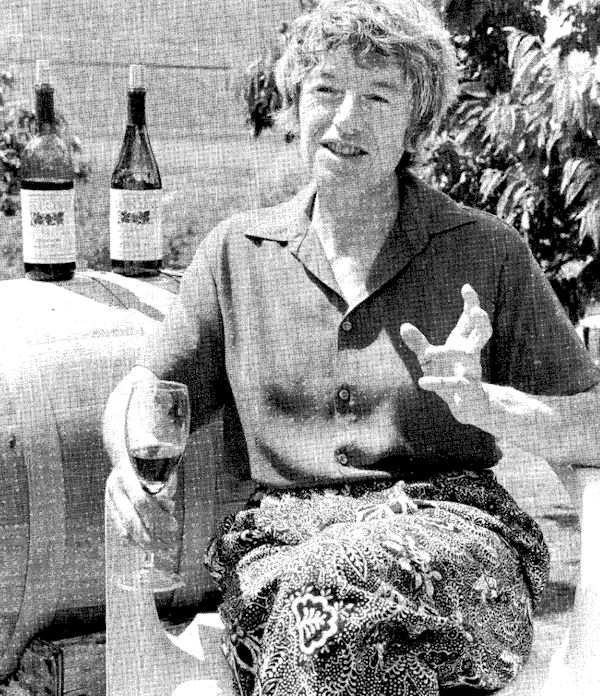
Vera Klokocka, was one of the pioneers of the Farmgate Winery movement in B.C. In 1979, along with her husband, Bohumir Klokocka, she bought a five acre orchard in the Okanagan that they, subsequently, tore out and replaced with grapes in 1984. This was the humble beginning of Hillside Cellars, now Hillside Estate. The first commercial release of a Hillside wine was the 1989 Auxerrois which received Hillside’s first VQA (Vintner’s Quality Alliance) seal of approval. She helped initiate the Farmgate Winery Policy, and was the first to plant Cabernet Sauvignon.
Lyall Denby, Director of pomology and grape research at the Summerland Research Station from 1971 until he retired in 1983, the Regina-born Denby joined the scientific staff at Summerland in 1950 after completing a master's degree in agriculture at the University of British Columbia. He was already an authority on ornamental plants, having gained experience working at a Vancouver nursery. At Summerland he gravitated toward vegetables and later toward tree fruits and grapes. He took over the grape program, with emphasis on developing winter-hardy varieties that had been launched by Dr. D.V. Fisher, who had moved on to become Summerland's director. Like many of his professional peers, Denby had reservations about the viability of vinifera grapes. Consequently, Summerland sought to breed varieties with vinifera flavor characters but with the vigor and hardiness of hybrids. The only wine grape from this work that became a commercial variety was the muscat-flavored sovereign opal, produced only by Calona as a varietal. Denby said later that other promising varieties were under development when he was diverted from that research to work on the so-called Becker Project, which focused on German vinifera. "I was forced into it," Denby said. "I would have preferred to put much of my own time into the next two generations of crosses. We had some good stuff coming on; opal was only one example."
With a small Canadian delegation, Denby toured the Soviet Union in 1973 and arranged to bring back from a research station in Yalta a number of Russian varieties. These included matsvani and rkatsetelli which were grown at Inkameep and which Brights turned into interesting varietals in small lots before the winery's accountants decided sales were too small to continue. The Russian varieties now are largely uprooted from Okanagan vineyards.
In the 80's work continued on virus diseases of tree fruits and grapes and a major achievement of this section is the development of a method whereby viruses can be eliminated from tree fruit propagation stocks by chemotherapy treatment.
Marcell Ercego In the province of Vicenzo in northern Italy, where Marcello Ercego grew up, it seemed to him that everybody grew grapes and made wine, including his farmer father who also required his help after school. "When you are a little kid, what do you do?" he shrugs. "When the old man is out there, pruning grapes, you got to go and clean the canes and prepare. That's the way people learn." Years later, he put those vineyard skills to work at his well-tended eight-acre Kaleden property where, with the help of a tractor affectionately called Toby, he grows chardonnay, gewurztraminer, chancellor, cabernet franc and merlot. He also makes his own, quite drinkable, wine. "I drink store-bought wine and I get sick," maintains Ercego, who also argues that the best way of crushing red grapes is still the original way his father taught him: with clean, bare feet.
Ercego -- the pronunciation is err-chay-go -- left Italy in 1957 after having learned to be a bricklayer. In Vancouver he earned his living in construction until an injury and subsequent arthritis led him, on a doctor's recommendation, to move to the Okanagan in search of a drier climate. He and his wife, Anna Maria, initially lived on a property in Kaleden with only a few acres of vines. Ultimately, Ercego, who was now helping build houses in the Okanagan, agreed to partner his neighbor and childhood acquaintance Silvio Bicego in buying and splitting an advantageously-priced but abandoned thirteen-acre orchard and gravel pit. Ercego thought he would have a house and a few cattle. The local authorities told him that he could only keep horses, not cows. "I don't like horses," Ercego says. Bicego took five acres for his own vineyard while Ercego had his rough, overgrown site expensively contoured and terraced to create the ideal site for growing grapes. "The hill had been so bad that you couldn't walk on it," Ercego recalls. The slopes are still steep but not too steep for Toby, the small four-wheel drive Japanese tractor that Ercego calls "my right-hand man" and that provided the agility threatened by Ercego's returning arthritis. "He'll do anything I want."
At first, Ercego planted the vineyard entirely to Okanagan riesling, virtually all of which came out after the 1988 vintage, to be replaced primarily by vinifera. Ercego still offers a vigorous defence of the Okanagan riesling as a winemaking grape, insisting that the fermentation needed to take place on the skins. Indeed, he was unhappy even to take out the grapes. "I cried that time, I tell you," he recalled. He protested to the newspapers and wrote to government before finally giving in. "We can't have everything, can we? Sometimes we have to take the good with the bad." His southern-sloping vineyard, with deep gravel under the topsoil, has enabled Ercego, a grower for Calona, to mature his vinifera and earn bonus payments most years. "The sun hits me in the morning," he notes. "I believe the morning sun makes the good fruit."
His son Bobby is now in charge. He is also vinyard manager for Terravista Vineyards.
Earl Cornish, moved to Kaleden BC in 1981 the property happen to have a vineyard growing gewurztraminer. His proudest moment came in 1994 when Jackson-Triggs produced an exquisite and rare late harvest wine from his gewurztraminer -- rare because a fully mature gewurztraminer seldom retains the acidity needed for late harvest wine. "When I read the back label, I feel pretty humble," Cornish said, referring to the gold type that proclaimed: "This vineyard has been individually selected for its ability to produce Gewurztraminer of the highest quality."
Paul Bosc opens Chateau des Charmes 1979
ANDRÉE BOSC
Madame Andrée Bosc – wife, mother and winery matriarch of Château des Charmes. She holds a B.A. from Brock University and a Masters in Public Administration from Niagara University, New York. Madame, as she is affectionately called, is a former French teacher who loves to welcome her former students to the winery. She is a tremendous ambassador for the winery. In 2006 she, along with her husband Paul Bosc Sr ,were named Niagara-on-the-Lake's Citizens of the Year and presented with the Lord Mayor's Award of Excellence.
Adolf Kruger checking out the first Wild Goose red wine bottling. 1989 Marechal Foch!Eden Raikes, veteran grapegrower who also was the first president of the B.C. Grape and Wine Institute in 1981. He stepped down in mid-1982 to retire to Hawaii.
Vern Rose, (1927-2018): Proprietor of House of Rose, a farmgate winery north of Kelowna. A retired schoolteacher from Alberta, Rose has been growing grapes at his vineyard since buying it in 1982. Self-taught winemaking skills have been buttressed with short courses taken at the University of California in Davis.
Adolf Kruger in 1983 purchased a barren piece of land east of Okanagan Falls. Upon his return to his newly purchased property he discovered a large flock of Canada geese feeding amongst the tumbleweeds, boulders, and rubble. As he approached, the flock of geese took flight and flew to the north. This vision inspired Adolf to call the property Wild Goose Vineyards. He was a leader was one of the pioneers of the Farmgate Winery movement in B.C. Also see Giants of Modern Times
Terry Wells around 1980 along with his wife Halina, purchased what they called the Tin Horn Creek vineyard south of Oliver. The twenty-acre Tin Horn Creek vineyard was named for the creek which flows through it. The grapes included foch, de chaunac, verdelet, and newly-planted chenin blanc, a variety which Wells came to regard as his favourite grape. He fought an uphill battle to make Chenin Blanc a prominent Grape in the Okanagan he lost his battle with the “1988 grape pull " the wineries would not purchase his grapes.
Wells also was a founding director of the British Columbia Wine Institute in 1991. Today only a few wineries grow Chenin Blanc; according for less than 1 % of the white wine grapes. Now called Wine Growers British Columbia (WGBC)Ted Brouwer palyed a major role in the Establishment of Inkameep Vineyards
Dr. Rodger Dial established Grand Prè Wines Limited in 1981 the first commercial farm winery in Nova Scotia.
Buchler, Hans: One of the leading organic grapegrowers in the Okanagan, the lean, lanky Buchler farms a seventeen-acre vineyard tucked into a bucolic, pine-covered valley high above Oliver. First planting 1983
John Harper, One of British Columbia's most determined independent grape nurserymen, Harper has devoted a life to horticulture. Born in Calgary, he was growing and exhibiting vegetables by his eighth birthday. After graduating from high school, he moved into the hospitality industry, working as a cook for Canadian Pacific, both on the company's trains and in its hotels in the West, where he began to learn about wines. His wine education blossomed in Europe during the Second World War, when he served as a catering manager for a Canadian forces hospital in Britain. He opened his first plant nursery in Steveston after returning from Europe but he established his reputation with a nursery he operated in Cloverdale for twenty years. He also worked as a fieldman both for Andrés and for Jordan & Ste-Michelle. At Cloverdale, Harper had so many experimental grape varieties there that, when he moved to a farm on Vancouver Island, south of Duncan, in 1983, he took 160 varieties for the modest vineyard he planted there.
Harper moved to Vancouver Island in search of a quieter life and lower property taxes. Unhappily for him, a group of promoters fastened onto the vineyard as the basis for a company whose research in tissue culture would qualify the company for money under the ill-fated Scientific Research Tax Credit program. While some serious tissue research was done, some of the moneys vanished on non-scientific projects before the federal government cancelled the entire program. Harper had had little to do with the SRTC program; he was entirely focused on the development of what could have been Vancouver Island's first cottage winery. His promoter partners had a company on the Vancouver Stock Exchange called Bitec Development Corp. which announced early in 1984 that $1.5 million was to be raised for Cobble Hill Estate Winery and Vineyards Ltd. The plan called for a fifty-acre vineyard which, optimistically, would produce and sell 180,000 bottles of wine annually by the fourth year of operation. Harper developed about half the vineyard acreage but the winery was never financed. In 1990 the vineyard was acquired by Hans Kiltz who used some of the Harper plantings to produce wines for his own Blue Grouse Vineyards farmgate winery which opened in 1993. Meanwhile, Harper and his wife Verna moved to a nearby twelve-acre property he called Ayle Moselle where a new vineyard and nursery was established.
Joe Busnardo founded Divino Estate Winery 1983. Planting his Oliver, BC vineyards with only Vinifera. He obtained his vines from Italy and University of California at Davis. He was one of the first to plant Pinot blanc which was to become a star in the Okanagan. He tried over 128 different varities in his vineyards.
Anton Jassacher, One of the cluster of grapegrowers at Kaleden, Toni Jassacher enjoyed a twenty-eight-year career as an electrician with Canadian Forest Products in Vancouver before buying vineyard land in the Okanagan. Born in the German-speaking South Tyrol (formerly Austrian but Italian since 1918), Jassacher grew up at Innsbruck in Austria, working there for the local power company until he emigrated to Canada in 1954. With little English, he worked for the Powell River Co. in a variety of logging jobs until his language skills enabled him to work as an electrician. After working with construction crews at the Kitimat aluminum smelter, Jassacher had had enough of remote coastal communities and settled in Vancouver, joining Canadian Forest. What drove him to the Okanagan was severe arthritis. "The doctor said I have to move to a drier climate."
One of his acquaintances in the Okanagan was Nick Brodersen, another former Canadian Forest Products electrician who had become a grower at Kaleden. One day in August 1983 Jassacher went to visit his friend. "The vineyard looked so lush, so beautiful," Jassacher recalled. "I said to him, is there anything for sale around here?" Brodersen directed him to a five-acre plot nearby with a new house on it but also so broken up by gullies that it seemed an unlikely vineyard site. Jassacher and his Hamilton-born wife Nancy, a twenty-eight-year career banker, bought it nonetheless, and had the gravelly terrain levelled and contoured into an excellent southeastern slope.
Knowing nothing about grapes, the Jassachers sought advice from Lloyd Schmidt, then one of the partners at Sumac Ridge and a respected vineyardist. After Schmidt moved to Ontario, Jassacher found that other mentors who offered abundant free, if conflicting, advice. "The first couple of years were tough. Finally I read German grape books and decided my own way." On Schmidt's instruction, he planted the vineyard in 1984 entirely to bacchus and grew that variety successfully for a decade before wineries decided the variety was losing fashion. His contract has moved from Sumac Ridge to Calona and finally to Gray Monk, which has an established market niche for the bacchus as a varietal wine. Yet when all contracts expired after the 1994 vintage, "nobody was really knocking down our door for the bacchus," Nancy Jassacher said. They decided to switch some of the vineyard to the hottest red variety and, in the spring of 1995, hired a professional crew to graft half of the 4,500 bacchus vines over to merlot. Unlike some other growers, Jassacher was not entirely pleased with the result, finding that only seventy per cent of the grafted vines grew successfully. It has convinced Jassacher to rely on his own counsel and on the lessons of his hard-earned experience. "I take so much care [in the vineyard that] some people think I am crazy," he said. In his own nursery he has cultivated merlot, cabernet franc and a small number of chardonnay vines for his vineyard. His meticulous touch carries over to home winemaking, also self-taught. His favorite wine? Bacchus with a touch of sweet reserve.
Frank Supernak
Frank Supernak, Born in Nanaimo, Supernak joined the T.G. Bright & Co. Oliver winery in 1984, shortly after graduating in microbiology from the University of British Columbia. During his first four years at the Oliver winery, a federal government grant funded intensive research and evaluation of the trial varieties, with Supernak gradually taking over making the wine from those grapes. He found that the Russian whites produced good wines, but not consistently so; the matsvani, for example, made fruity wines one year, neutral wines the next. Eventually, the winery dropped all the eccentric varieties except the sereksia chornaya, an excellent rosé, which was re-launched in 1992 as Blanc de Noirs. The renaming of that wine was necessary because the Brights marketing department found it too difficult to sell the Russian tongue twisters. Supernak, who took over the winemaking at Oliver in 1992, describes the purple-skinned sereksia chornaya as "the most interesting grape I have ever worked with." However, he has the winery now focused on mainstream varietals, including chardonnay, riesling and ehrenfelser, usually vinified into crisply dry wines. The baco noir was dropped, with the winery now concentrated on vinifera varietals only. The major red varietal made in 1992 by Supernak was a merlot with grapes from the Columbia Valley in Washington state; ultimately, adequate supplies of merlot have become available in the Okanagan. Supernak left Vincor (as Brights had become known) in May, 1996, after he became associated with a group of investors negotiating to buy the Divino winery.
In 1996, he left to take over making the wines and overhauling the vineyard at the newly-formed Hester Creek Estate Winery south of Oliver. Here, he established a deft winemaking touch with Pinot Blanc, Trebbiano, Merlot and Cabernet Franc.
In July 2002, Mr. Supernak established his own consulting company, called It's About Wine, in response to requests from several new wineries, including Chalet Estate Winery on Vancouver Island, Silver Sage and his major client, Blasted Church Vineyards of Okanagan Falls. He also was a long-time member of the Vintners Quality Alliance tasting panel in the Okanagan and served on the board of the Okanagan Wine Festival Society. As a wine educator, he gave his time generously to all who shared his passion for wine, including many home vintners.
On November 10, 2002, winemaker Frank Supernak lost his life in a failed attempt to save a co-worker who had accidentally fallen into a wine fermentation tank, in Oliver, British Columbia. Although aware of the danger caused by the poisonous carbon dioxide found within fermentation tanks, Mr. Supernak tried to pull his unconscious colleague from the container. When his efforts proved unsuccessful, he jumped into the vat and attempted to rescue his friend by lifting him out to safety. Within seconds, Mr. Supernak also succumbed to the deadly fumes and lack of oxygen, and could not be revived. He was awarded the Govenor Generals's Award of Bravery.
Bill Drinkwater, (1928-2016): Until the unusually cold November of 1985, Bill Drinkwater's Basque Vineyard was one of British Columbia's most northerly vineyards -- and the only one in the Thompson River valley. The grapes were high quality but the site was not.prior , he bought six acres in East Kelowna in the mid-1960s which included three acres of grapes, primarily diamonds, a labrusca variety. As his interest in grapes grew, he bought a twenty-seven-acre property with an orchard and a vineyard in the Belgo district, northeast of Kelowna. Here he grew marechal foch and himrod, among other hybrid varieties. He also involved himself in grower politics and was president of the B.C. Grape Growers Marketing Board in 1978. By that time Drinkwater concluded that the Kelowna vineyard did not get enough heat units to mature his grapes to optimum levels. He sold that property and, after an extensive search, bought 100 acres of sagebrush-covered land in the Basque district on the east flank of the Thompson, about ten miles south of Ashcroft, a small ranching and mining community.
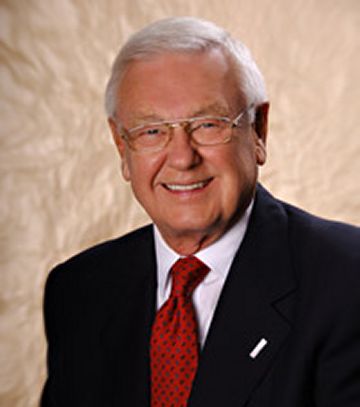
Senator Ross Fitzpatrick
Senator Ross Fitzpatrick founded CedarCreek Estate Winery 1986. He became a pioneer in the planting of vinifera grape varieties to produce premium quality wine. Today, almost all wine grapes grown in the province are vinifera varieties. CedarCreek collected numerous awards, including being named the Canadian Winery of the Year twice. In 2014 the Fitzpatrick family sold CedarCreek but was not prepared to completely leave the industry. The family-owned Greata Ranch Reserve Winery, located between Summerland and Peachland, has been expanded to focus on producing high-quality Okanagan sparkling wine.
Anthony von Mandel bought Golden Valley Winery in 1981 with Nick Clark . They renamed the winery back to its original name of Mission Hill. Nick Clark sold his half of the winery to Anthony von Mandel. Please see Mission Hills
Nick Clark The entrepreneurial first president of the British Columbia Wine Institute when it was formed in 1990, Victoria-born Clark has had significant impact on the British Columbia wine industry since entering it in 1975. A 1968 graduate in industrial engineering from the Hamilton Institute of Technology, Clark was recruited from a management job at the Canadian post office to become the first director of purchasing for the Liquor Distribution Branch in Vancouver where he was one of the proponents of the so-called Agent Stocking Program. This was a crafty program under which the wine and spirits agents selling to the LDB were effectively required to take over from the LDB the responsibility for warehousing products. The LDB thus reduced its inventory costs by millions and generated more profit for the government. In 1981, Clark partnered with wine merchant Anthony von Mandl to buy Mission Hill winery at Westbank. Clark, who initially owned a quarter of the shares, served as president until selling his interest in 1989 to take a year's sabbatical with his wife Norah and their two daughters. A consulting assignment he did in 1990 on exporting British Columbia wines led to the newly formed Wine Institute giving Clark an eighteen-month contract to be its first chief executive. By the time he stepped down, the Institute was firmly established, with the highly effective VQA program in operation.
Raffeiner, Joe Cellarmaster and winemaker at Golden Valley winery, he was retained as cellarmaster in 1981 when the winery was acquired by Anthony von Mandl and Nick Clark
Guenther Lang, Born near Stuttgart in Germany, Lang was a junior manager with Daimler-Benz when he and his wife, Kristina, decided to emigrate the year after a 1979 vacation in the Okanagan. He bought a farm near Naramata with a nine-acre vineyard, learned to grow grapes and made his first wine in 1981. A growing list of awards in amateur competitions led him to begin in 1985 applying for a winery license that was granted five years later, when the new farmgate winery license had been created.
Albert Piggott, The founder of Merridale Cider Works Ltd, 1987, on Vancouver Island, Piggott was born in the town of Forfar on the east coast of Scotland. Technically trained in engineering and architecture, Piggott taught shop crafts until he and his wife, Betty, came to Canada in 1954, judging the opportunities better. Here, Piggott continued his teaching career on Vancouver Island until retiring at fifty-six to concentrate on a new passion: making genuine English cider. Piggott had been making fruit wines and apple ciders much of his adult life both in Scotland and in Canada. For Merridale -- the cidery is at the end of Merridale Road near Cobble Hill -- Piggott has an orchard planted with a complex selection of cider apple trees, varieties seldom seen outside France and Britain. New owners Janet Docherty and Rick Pipes who took over in 2000
Lang Vineyards: The first of British Columbia's farmgate wineries, Lang Vineyards, opened May 25, 1990. Guenther Lang first applied for a winery license in 1985 but found his nine-acre vineyard was too small for an estate winery, which is required to have twenty acres. When written in 1978, the estate winery rules perversely shut the door on many would-be vintners, since the average Okanagan vineyard was then only fifteen acres; and that average dropped to just eight acres after 1988, when two-thirds of all vines, including several entire large vineyards, were uprooted. Lang lobbied persistently, along with Adolf Kruger, Vera and Bohumir Klokocka and Wolfgang Zeller, until the province created the new farmgate winery category in 1989 for small growers
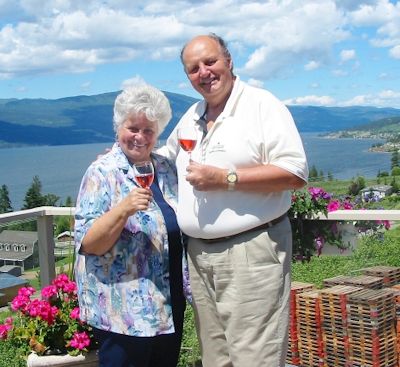
George and Trudy Heiss Gray Monk Winery
George and Trudy Heiss opened Gray Monk Family Winery in 1982. The Heiss family has had a profound impact on Okanagan wine growing. They were the first to import clones of Pinot Gris, Gewürztraminer and Auxerrois from Alsace. They facilitated the Becker Project, an eight-year trial of German vines that, by its conclusion in 1985, proved the viability of varieties now among the most important in the Okanagan. Among all the wine producers in North American, they alone nurture the hard-to-grow Rotberger grape to make notable rosé.
Daniel Lagnaz, The winemaker at Mission Hill from 1982 until 1992 when he became the company's Vancouver-based export manager, Lagnaz was born in the Swiss winemaking district of Aigle. After gaining experience there and in Spain as a vintner, Lagnaz in 1980 joined the Lindemans winery in Australia. He was recruited to Mission Hill two years later, produced a remarkably broad range of wines, ciders and eau-de-vies and quickly had the previously troubled winery winning awards and praise for the quality of its wines.
Wolfgang Zeller immigrated to the Okanagan in 1983, he become a major source of vineyard and winery equipment in British Columbia. His first contract was with T.G. Bright & Co. He planted what he wanted, not what the wineries advised. He was told to plant de chaunac, vidal and Okanagan Riesling; instead, he started with johannisberg riesling and pinot noir, telling the wineries that he might be a newcomer but he knew something they did not. In 1988, nothing had to be pulled from the Zeller vineyard at Naramata and, with the immediate shortage of good wine grapes after the pullout, he had no difficulty selling his fruit to wineries. By then his eight-acre vineyard had been expanded to include müller-thurgau, ehrenfelser and the mother block of two thousand oraniensteiner vines, a German white variety obtained for Zeller by Brights, which later Brights lost interest in.
Dr. Hans Kiltz: The proprietor and winemaker at Blue Grouse Vineyards near Duncan on Vancouver Island, Kiltz was born in Berlin and has a doctorate in microbiology. He practised as a veterinarian for twenty years in Africa and Asia. In 1988 he and his wife Evangeline moved to Canada to have their two children educated here. They purchased a picturesque farm in the Cowichan Valley previously operated as a vineyard by veteran grapegrower John Harper. Kiltz, whose relatives in Germany are winegrowers, continued tending -- as a hobby -- the vines left behind by Harper. When the government allowed farmgate wineries, Kiltz secured a license and opened Blue Grouse in 1993. Specialties based on the seven-acre vineyard include pinot noir, pinot gris, müller-thurgau, bacchus and ortega.
Along with Gunther Lang, Adolf Kruger and Vera Klokocka, Zeller campaigned for the right to open a farm winery. By the time the farmgate license was created in 1989, Zeller & Sons Enterprises Ltd., his machinery import company had become too successful for him to consider a winery.
Dick DeGussem, The proprietor, with his family, of Gersighel Wineberg south of Oliver, DeGussem was born on a farm near Ghent, in Belgium's Flanders Fields. "We were potato farmers," he says. His enthrallment with grapes began in 1966 when he went to Pomerol in France as a picker. He returned to the family farm but in 1970, after marrying, he and his wife Gerda moved around Europe and even, in 1981, spent six months in South Africa, in search of a place where he could grow grapes and make wine. Along the way he developed a taste for poetry. DeGussem not only writes poetry in English and in Flemish; with his long, undisciplined hair and flashing eyes, he looks the part and is prone to uttering mysterious aphorisms and references to Homer in conversation with visitors to his winery.
DeGussem brought his family to Canada in 1986, buying an orchard and vineyard on the west side of Highway 97, between Osoyoos and Oliver. In 1989, the fruit trees were replaced with more vines, among them premium varieties such as pinot noir, pinot blanc and chardonnay. The Gersighel farm winery opened in the summer of 1995 with two vintages of pinot blanc for sale and chardonnay still to be bottled. Unhappily, none of the 1994 vintage of pinot noir survived the assault of the birds; in 1995, DeGussem began protecting his vines with nets. He is enthusiastic about the potential for his site, a sliver of soil wedged between the highway and the low mountains to the west, that shield the vineyard from the late afternoon sun. "This is Burgundy country here," he insists. "When it is too hot, you have problems with pinot noir." He has an acre of this variety and is enthusiastic about it, even while admitting it is a difficult grape to grow and vinify. "You have to look after it like a chicken on a bed," he says, lapsing into one of his aphorisms. Equally mysterious is the winery's label. The fetching damsel stomping grapes in a basket, DeGussem says with an enigmatic smile, is a memory from Europe.
Dionisio (Dennis) Zanatta came to Canada in 1959 He settled on a farm just south of Duncan in the Cowichan Valley on Vancouver Island . He started an experimental plot of grapevines in 1970 with varieties such as leon millot, a red French hybrid, obtained from the federal government's plant health centre at Saanich. In 1983 Zanatta extended his trial plot, cooperating with the B.C. government in the so-called Duncan Project, a six-year trial in which more than 100 varieties were tested for their suitability on Vancouver Island. Midway through the trial, Zanatta began a five-acre planting of ortega, a white variety suited to the long, cool growing season of the Cowichan Valley. It formed the basis for the Vigneti Zanatta farm winery that opened in 1992 when his daughter, Loretta, completed her training as a winemaker in Italy.
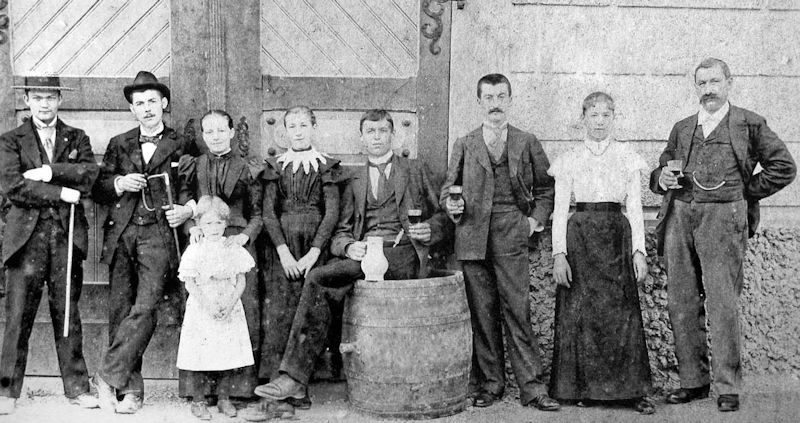
The Konzelmannn Family from Germany to Canada
The man on the far right is Herbert Konzelmann's great-grandfather Freidric Konzelmann and the man sitting on the barrel is his grandfather, Otto Konzelmann.
Herbert Konzelmann a 4th generation winemaker arrived (1984)from Germany and established Konzelmann Estate Winery . Konzelmann was officially the seventh winery to open its doors in Ontario. They were the first Canadian winery to make Wine Spectator’s Top 100 in 2008 with their highly acclaimed Vidal Ice Wine VQA 2006.
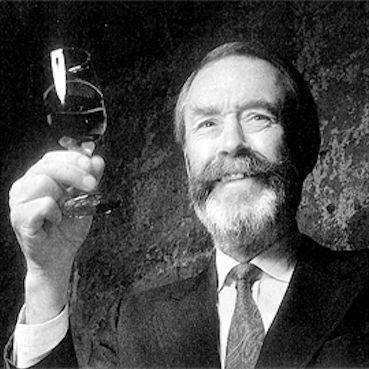
Thomas J Muckle pathologist, professor, winemaker extraordinaire, self-taught pianist and composer and champion of unconventionality. One of three men who started a winery that involved into Thirty Bench
Robert Murray a Berry Crop specialist became the man in charge of developing programs for Grape Growers Association of Nova Scotia. Over the years he helped numerous vineyards develop their vineyards. Bob has also received many honours including the Recognition Award from the Nova Scotia Strawberry Growers Association, Distinguished Agrologist Award, Honorary Member: Grape Growers Association of Nova Scotia, NSIA Distinguished Life Membership Award and Honorary Member NSFA Senate Club. Jost Vineyards felt Bob's leadership to the Nova Scotia grape and wine sectors were so momentous they named their 1992 Seyval Blanc wine the “Robert Murray Select”.
Dr. Andrew Jamieson, who is based at the Atlantic Food and Horticulture Research Centre, in Kentville, N. S.has been working in Nova Scotia for over twenty years researching grapes and other fruits. Andrew works closely with the Grape Growers Association and growers evaluating promising selections
Christian Barthomeuf one of the modern pioneers of viticulture in Québec, planted the first vineyard in Dunham in 1970 and invented ice cider (also know as ice apple wine) in 1989.
Gary Strachan joined the staff of the Food Processing Section in 1977. By 1978, Strachan needed more assistance with his energetic wine evaluation program and Barbara Edwards was hired as his technician. Strachen and his staff made wine from the short listed Summerland breeding selections along with wines from the Becker Project and several BCMAF sites. One site was at the Inkameep Vineyard, another at what is now Zanatta Winery on Vancouver Island. They also had a large cooperative project at the Station to evaluate (mostly) Eastern European grape varieties.
Harry von Wolff, purchased the property on Vancouver Island in 1987 to develop Nanaimo’s first winery Chateau Wolff Estate .With his wife, Helga, Harry settled in Nanaimo in 1977 and prospered in retailing western clothing and footwear. Harry now became a competent amateur winemaker and, after planting a few vines at his home, established this vineyard. An admirer of the wines of Burgundy, he planted Pinot Noir and Chardonnay in the best site, a southwest-facing slope against a sunbathed cliff. His first commercial vintage was 1996 and he opened the winey in 1998.
Bruce Schmidt marketer who turned Calona’s Schloss Laderheim into Canada’s largest selling white wine in the 1980s.When he started his own marketing and venture capital consulting firm in 1987, one of the clients he helped raise capital for was Blue Mountain Vineyard & Cellars. In 2007 founded Intersection Winery.
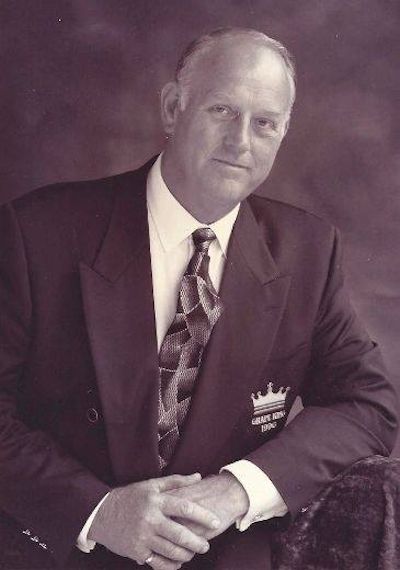
Howard Staff -photo credit Ontario Grape Growers
Howard Victor Staff- Howard was most content on the farm where he was born, worked and passed. Howard was a leader and contributor to agriculture and the community. Amongst other postings in agriculture, he served as President of the Ontario Fruit and Vegetable Growers Association and Vineland Growers Co-Operative; Chairman of the Board for the Lincoln Committee of Adjustment; one of the longest serving Board of Directors and Committee Members of the Grape Growers of Ontario; Vice-President of A.C.C. Farmers Financial; Commissioner of the Niagara Escarpment Commission; Member of the Agricultural Adaptation Council; Board of Directors Welch's U.S.A.; Founding Committee and Major Contributor of the Cool Climate Oenology and Viticulture Institute at Brock University. His dedication to community saw him volunteer with Lincoln District Firefighter Station #4 (Jordan); member of the St.Catharines & District Shrine Club; chair the Beamsville District Secondary School 125th Anniversary; and chair the Jordan Historical Museum. Howard's efforts did not go unnoticed by the public at large as he was awarded the Paul Harris Award by the Rotary Club of St.Catharines South for outstanding lifetime contribution to community; Lifetime Achievement Award by the Niagara North Federation of Agriculture for exemplary contribution to the agriculture community; Royal Order of the Grape and 1996 Grape King awarded by the Niagara Grape and Wine Festival; 25 Year Service
Award by the Province of Ontario for outstanding efforts in volunteering; and Awards of Merit from the Grape Growers of Ontario for over 50 years of grape farming, Green Ribbon Taskforce Region of Niagara Police, and Ontario Fruit and Vegetable Growers Association for outstanding commitment to horticulture in Ontario.
Guenther Lang founder of Lang Vineyards which opened its doors in 1990 after a lobby effort led by Guenther succeeded in having Premier Bill Vander Zalm’s government enact regulations to enable small farm wineries to be established. The first release from the vineyard, a 1989 Marechal Foch, won a gold medal at the Atlanta International Wine Festival.
Adolf Kruger in 1983 purchased 10 acres on a stony slope in Okanagan Fall. He planted 5 acres each of Riesling and Gewürztraminer, becoming one of the first growers of such classic varieties in the Okanagan. He travelled from his job in Calgary to the Okanagan for a year before finding work in Pendicton. Adolf first planted Riesling and Gewurztraminer; he quickly secured a contract to sell the grapes to Mission Hill Winery. He opened the winery in 1990.
Klaus Reif and winemaker Ron, 1979 Reif Estate Winery. Founded in 1982 by Ewald Reif and later acquired by nephew Klaus W. Reif. Today, Reif produces wines from its vineyard first planted in 1977.Ivan Lessner, Born in Budapest to a family that had been winegrowers and wine merchants for more than 200 years, Lessner grew up in Vienna to which his family had fled in 1956 when the Soviet Union crushed the Hungarian uprising. A winemaking graduate of Geisenheim, Lessner came to Canada at attend a cousin's wedding in 1980. A social telephone call to a fellow Geisenheimer working at Jordan & Ste-Michelle landed Lessner a research job at the winery's St. Catherines, Ontario, plant. The following year he became the winemaker at the company's Calgary winery and in 1984, he was promoted to winemaster at the company's Surrey, B.C. winery. When that winery closed, Lessner established his own company in Whiterock, B.C., IDL Consulting, representing European winemaking machinery and supplies.
At the Surrey winery, the range of wines made by Lessner and winemaker Joseph Vollmer included prize-winning johannisberg rieslings. They also had fun with the wines. In 1986 Lessner, a sportscar buff and a member of the Austin-Healey Club of British Columbia, proudly bottled fifty cases of riesling with an Austin-Healey label for a club rally in Whistler.
Gordon Gehringer, A co-proprietor of Gehringer Brothers Estate Winery opened in 1986, Gordon Gehringer was born in Oliver and trained as a winemaker at Weinsberg in Germany. A shy, self-described "man of few words," he occupies himself in the winery and in the adjoining vineyard and leaves public relations to his older brother, Walter.
Walter Gehringer, Born in Oliver, Walter Gehringer in 1978 became the first Canadian to graduate from the Geisenheim Institute in Germany. Returning to Canada, Walter Gehringer worked for Andrés in Ontario and British Columbia while the vineyard south of Oliver, purchased in 1981 by the Gehringer family, was planted in the varieties desired for the estate winery which opened in 1986. It is operated by Walter and his younger brother Gordon, with their father Helmut and uncle Karl as silent partners.
John Simes the first winemker from the Southern Hemispere to work in the Okangan. He came in 1992 to work at Mission Hill. That year he made Grand Reserve Chardonnay which won the Avery's Trophy for The Best Chardonnay (1994) at the International Wine and Spirt Compentition in London
Jim Wyse In 1993 he put together investors to purchase property on Black Sage Road. It was to become Burrowing Owl Estate Winery. He hired winemaker Jim Dyer. The tasting room fees were used toestablish a fund for the Burrowing Owl breeding program.
ModernEra Giants of the Industry
|
